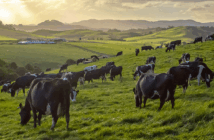By Dr Jocelyn Eason, general manager of Food Innovation for Plant and Food Research
The health benefits of a fibre-rich diet have been widely promoted. Yet, despite popular understanding around the importance of fibre-rich diets and the increased consumer demand for fibre foods, many consumers are still not eating enough.
University of Otago studies published in the Lancet and PLOS Medicine in the last few years link intakes of dietary fibre and whole grain foods to a reduced risk of non-communicable diseases, including coronary heart disease, stroke, type 2 diabetes and colorectal cancer.
In addition to promoting feelings of satiety (feeling full and satisfied), dietary fibre helps slow digestion and control blood sugar and blood pressure. Derived from the parts of plants that are not broken down during digestion, fibre is plentiful in plant foods like vegetables, fruits, wholegrains, cereals, potatoes, beans and legumes, and especially abundant in the skin and outer layers.
Given the wealth of information around the importance of fibre in diets, along with the quantity of available fibre-rich foods, the fibre deficit between what people should eat and what they do eat is startling. Consumers obviously find it challenging to consume as much fibre as they should, around 30g per day, and struggling to eat an adequate volume of fibre-rich foods can be exacerbated by the avoidance of gluten and eating less cereal. This widespread dietary deficit provides an opportunity for food producers to innovate to fulfil a demand for fibre-rich foods that are convenient and taste great.
Dietary fibre, unlike many other ingredients, fits into the established trend favouring clean label ingredients. For food manufacturers, this means they can promote consumer health by incorporating dietary fibre in non-traditional fibre products, like yoghurt or even ice cream, or in novel innovative product formats. They could strive to create products that are good (4g/serve) or excellent (7g/serve) sources of dietary fibre.
With fibre, one size does not fit all. It is essential to select the right fibre ingredient for each offering, as different forms of fibre have different properties. For example, some fermentable fibres, like inulin, impart health benefits by promoting growth and activity of good bacteria in the human gut.
Dr Jocelyn Eason has a PhD in Plant Physiology from Otago University and an MBA from Massey University. In her current role, she manages Plant and Food Research’s Food Innovation Portfolio, which includes teams that investigate human responses to food, the influence of food on human nutrition and wellness, and the production and supply of nutritionally rich foods
The information and opinions within this column are not necessarily the views or opinions of Hot Source, NZ Food Technology, or the parent company, Hayley Media.





























































































